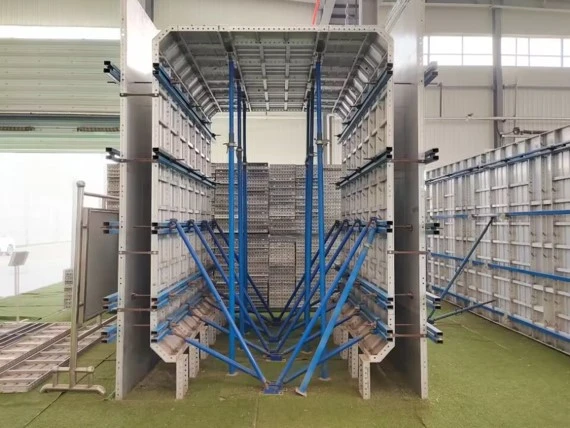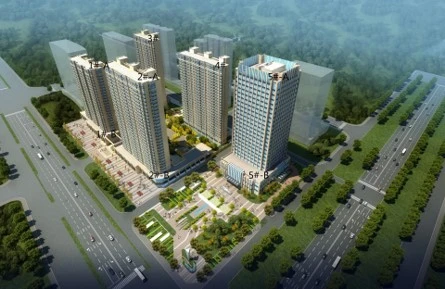Steel Formwork
● What is steel formwork
Steel formwork which is a special construction metal formwork, mainly used for the template decoration of concrete structures including walls, beams, columns, and other components.steel formwork is characterized by high strength, durability, low cost, and high efficiency, which can greatly improve the speed and quality of construction.
Using steel formwork can also reduce the use of wood, save resources, and environmentally friendly.
Steel formwork also can satisfy the large-span, high-load, and complex-shaped building construction, which is widely used in buildings, bridges, tunnels, water conservancy projects, and other fields.
● Different types of steel formwork
Beam formwork: used for pouring beam structures.
Column formwork: used for pouring column structures.
Wall formwork: used for pouring wall structures.
Slab formwork: used for pouring flat structures such as floor slabs and roof slabs.
● Steel Formwork Advantages
1.High Strength
The strength of steel formwork is very high, capable of enduring substantial pressure and loads. Thus when using steel plate formwork in construction, can reduce the risk of deformation and at the same time ensure the quality and safety of the construction.
2. Good Stability
The steel formwork for concrete owns good stability, resisting bending and deformation. This advantage allows the steel plate formwork to remain stable during construction, enhancing the precision and efficiency of the construction.
3. Long-Lasting Durability
The building steel formwork has a long service life, typically lasting up to 50-100 times. This feature makes the steel formwork becomes long-term investment, significantly reducing construction costs for enterprises.
4. Easy to Operate
The building steel formwork is easy to operate due to its modular design. Easy to transport, install, and also dismantle, saving considerable labor and time costs.
5. Wide Range of Applications
The steel frame formwork is suitable for various types of buildings, including residential, commercial, and industrial structures etc. This feature makes steel frame formwork a bright future in the construction industry.
6. Environmentally Friendly
The steel frame formwork can be use repeatedly, reducing environmental damage and pollution. Additionally, it can further reduce the impact on the environment through recycling use.
7. Cost Reduction
Although the initial investment cost of steel frame formwork is relatively high, its long service life enables companies to save significantly on maintenance and replacement costs. Moreover, due to its ease of operation, it reduces labor costs, further enhancing the efficiency of the enterprise.
● Steel formwork details
| Material | Q235 steel plate |
| steel formwork sizesLength | 900-1800mm |
| Width | 200-600mm |
| Height | 55mm |
| steel formwork thickness | 3-5mm |
| Welding Technique | CO2 Arc Welding |
| Surface Treatment | spray painted, powder coated |
| steel formwork accessories | steel tie rod formwork, steel formwork shuttering clamp,steel formwork ties |
● Use of Formwork Steel
With the development of the construction industry, steel formwork is widely used in construction projects.
Our steel formwork for sale is made of high-quality steel and is a reusable template that effectively improves construction efficiency and quality. Formwork steel can be used in different types of construction environment, see below:
1. Civil Engineering: concrete construction steel formwork is highly used in concrete structures such as high-rise residences, underground garages, foundations, and industrial factories. It provides precise template dimensions, enhancing accuracy and speed. Compared to wooden forms, it has a longer lifespan, reducing material waste and labor costs.
2. Bridge Engineering: concrete construction steel formwork is essential in bridge construction, especially for large-span and specialized bridges. It is more strong, stable, and seismic-resistant than wooden forms. In harsh environments like strong winds and oceans, it is the preferred choice.
3. Tunnel Engineering: concrete construction steel formwork is indispensable in tunnel construction, whether for subway or road tunnels. Its precise fabrication ensures accurate dimensions and shapes, shortening the template construction time. Its longer lifespan reduces costs and construction duration.
● Steps Of Using The Steel Formwork
1. Select proper material and specifications.
Steel formwork panels are typically have Q235B steel, Q345B steel, stainless steel, etc., thickness of steel normally are 3mm to 5mm. Choose appropriate specifications, sizes, and processing methods based on the requirements of concrete pouring.
2. Steel formwork installation.
According to the design requirements, assemble the prefabricated steel formwork components by connecting various parts with bolts or welding, forming a complete formwork structure.
3. Lubrication of steel formwork.
Before concrete pouring, lubricate the surface of the steel formwork to prevent the concrete from sticking to the formwork. Commonly materials include paraffin wax, petroleum, etc.
4. Concrete pouring.
After installing steel props formwork and scaffolding on the steel formwork, concrete pouring can begin. During the concrete pouring process, attention should be paid to the uniformity and compactness of the concrete. Use electric vibrating rods to expel the cement from the steel plate formwork and exclude air bubbles. The timing and the size of the vibrating rods are crucial. Select proper sized rods and proceed with the operation.
5. Dismantling after finish. Once the concrete has fully cured, the steel plate formwork can be dismantled. During dismantling, be careful not to damage the surface of the steel plate formwork to ensure its reuse in the future.
● What is steel circular column formwork?
In the process of building construction, cylindrical columns are crucial components that bear and transmit floor and structural loads. Traditional cylindrical column construction often requires significant manpower and time, and is easily to quality and safety issues. However, with the continuous development of technology, steel circular column formwork as an innovative solution, is gradually gaining attention and application in the construction industry.
Definition:Steel circular column formwork is a reusable steel formwork system made of high-strength steel used for the construction of cylindrical columns. It consists of steel plates, a support system, and connecting components, which can be freely assembled and adjusted according to specific needs.
● Features
1. High Strength and Durability:
Steel formwork for column is made of high-strength steel, owns excellent bearing capacity and durability.
It can keep heavy loads and maintain stable performance after multiple uses.
2. Reusable:
Compared to traditional wooden formwork, steel formwork for column can be reused multiple times, reducing material waste and lowering construction costs.
3. High Accuracy:
Steel circular column formwork has precise plate fabrication and excellent dimensional stability. Through precise manufacturing and adjustment, it ensures accurate dimensions and shapes of the cylindrical columns, improving construction quality.
4. Quick Installation:
Circular steel formwork adopts a modular design, making installation simple and fast. Workers only need to perform simple assembly and adjustment to complete the construction of the cylindrical columns, significantly reducing the construction period.
5. Safety and Reliability:
Circular steel formwork has good seismic performance and stability, effectively ensuring the safety of workers during construction. Meanwhile, its smooth and flat surface reduces defects and repairs on the concrete surface
● Steel formwork vs aluminium formwork
Aluminum formwork and steel formwork are both materials used for concrete formwork support in constructions, and they are widely applied in industrial factories, civil buildings, bridges, tunnels, and other construction projects.
Aluminum formwork is composed of aluminum alloy plates. It has the advantages of light weight, high strength, corrosion resistance, and low deformability, making it suitable for formwork support in high-rise buildings, bridges, tunnels etc.
Steel formwork is made of high-quality cold-rolled steel plates, with the surface processed through spraying, embossing, turning, polishing, and other techniques.
Their differences as following:
1. Quality
Aluminum formwork is composed of aluminum alloy plates, which have good toughness and pressure resistance. While steel formwork system is made of high-quality steel plates, which have higher strength and abrasion resistance. However, aluminum formwork is lighter but more prone to deformation compared to steel formwork.
2. Weight
Aluminum formwork is relatively lightweight due to its material, and each piece can bear a relatively small load.
Therefore, it is easier to handle and assemble during construction. In contrast, steel formwork is relatively heavier and usually need mechanical equipment for carrying and assembly.
3. Lifespan
Due to its greater weight and higher durability, steel formwork for concrete has a relatively longer lifespan and can be reused more times during construction. However, the lifespan of aluminum formwork can be shortened due to deformation, typically lasting around 5 years.
4. Range of Application
Steel formwork for concrete is suitable for large-scale construction projects, often requiring lifting equipment or motorized vehicles for carry and installation, such as high-rise buildings, bridges, and tunnels. In contrast, aluminum formwork is suitable for situations that require high load-bearing capacity and frequent disassembly.
● Recommended Pages

